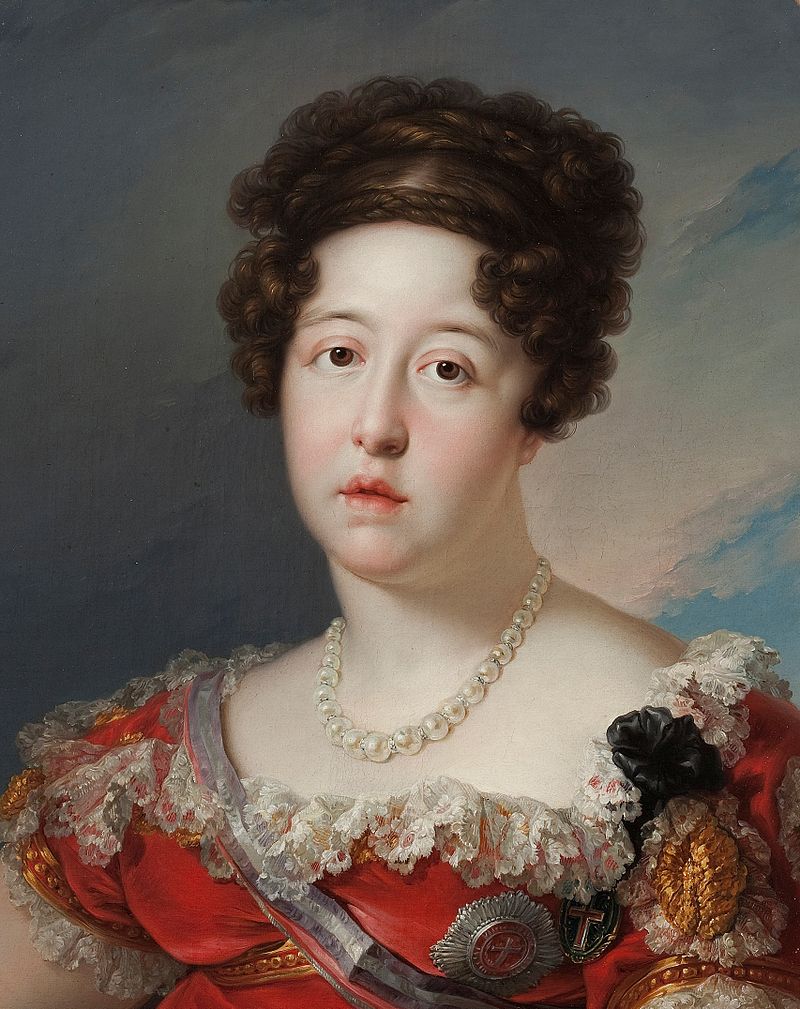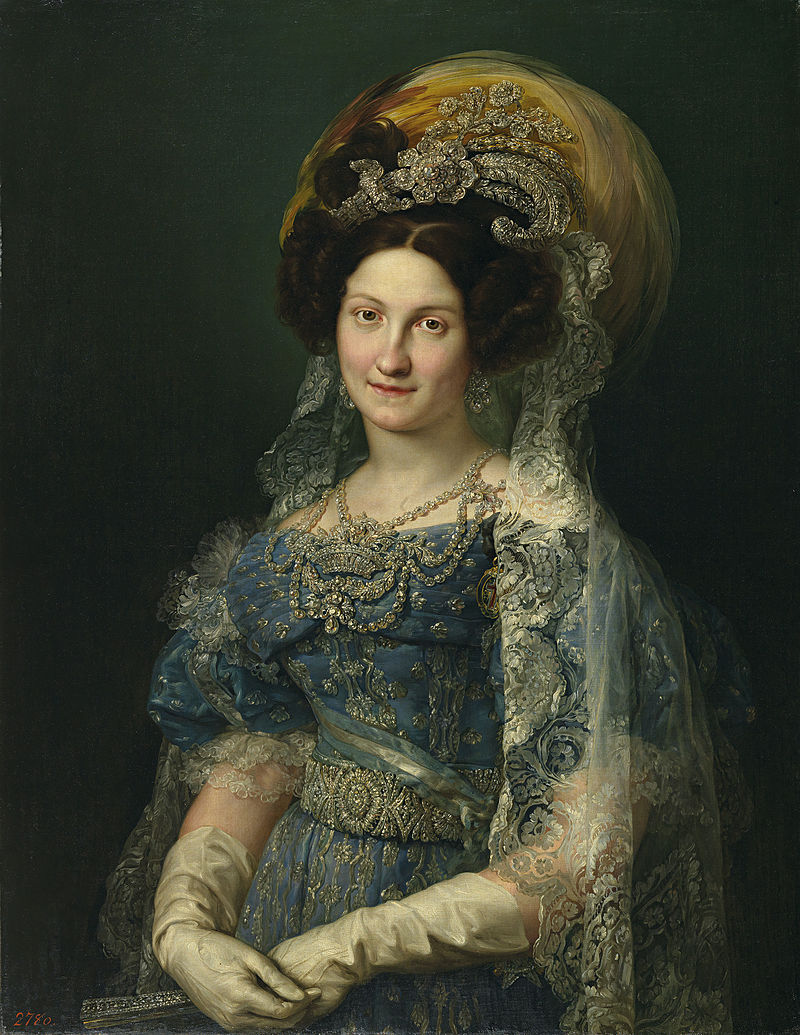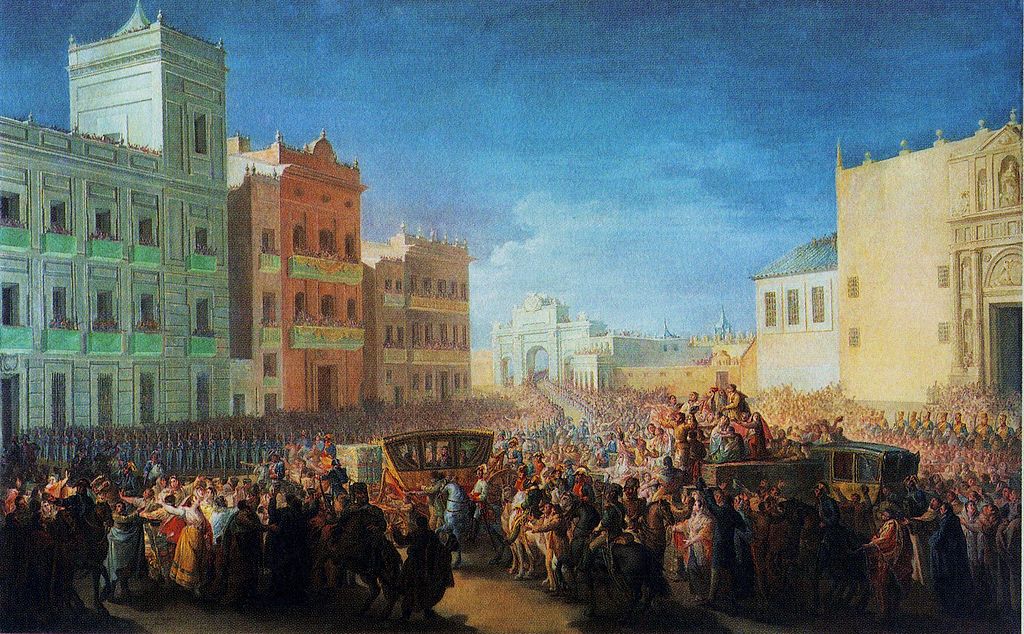by Susan Flantzer © Unofficial Royalty 2015

Credit – Wikipedia
King Ferdinand VII of Spain (Fernando Maria Francisco de Paula Domingo Vicente Ferrer Antonio Jose Joaquin Pascual Diego Juan Nepomuceno Januario Francisco Javier Rafael Miguel Gabriel Calixto Cayetano Faust) was born on October 14, 1784, at El Escorial, a royal palace in San Lorenzo de El Escorial, Spain about 28 miles from Madrid. His parents, King Carlos IV of Spain and Maria Luisa of Parma, had fourteen children and Ferdinand was the ninth child and eldest son of the six children who survived into adulthood.
Ferdinand’s siblings:
- Carlos Clemente (1771 – 1774), died young
- Carlota Joaquina (1775 – 1830), married King João VI of Portugal, had issue
- Maria Luisa (1777 – 1782), died young
- Maria Amalia (1779 – 1798), married her paternal uncle Infante Antonio Pascual of Spain; died after giving birth to a stillborn son
- Carlos Domingo (1780 – 1783), died young
- Maria Luisa (1782 – 1824), married Louis, King of Etruria, had issue
- Carlos Francisco de Paula and Felipe Francisco de Paula, twin boys (1783 – 1784), both died young
- Carlos, Count of Molina (1788 – 1855), married (1) his niece Maria Francisca of Portugal, had issue (2) Maria Teresa of Portugal, had one son
- Maria Isabel (1789 – 1848), married (1) King Francesco I of the Two Sicilies, had issue (2) Francesco, Count del Balzo dei Duchi di Presenzano, no issue
- Maria Teresa (1791 – 1794), died young from smallpox
- Felipe Maria (1792 – 1794), died young
- Francisco de Paula, Duke of Cadiz (1794 – 1865), married (1) his niece Luisa Carlotta of Naples and Sicily, had issue (2) Teresa de Arredondo y Ramirez de Arellano, had one son

Family of King Carlos IV of Spain in 1802; Credit – Wikipedia
Ferdinand was educated by a priest, Father Felipe Riaza Scío, a teacher and translator, who became Bishop of Segovia in 1895. While growing up, Ferdinand was denied any participation in government affairs by his parents and his mother’s favorite and possible lover, Manuel Godoy, Prime Minister. Ferdinand was encouraged by his teacher to conspire against his parents and a group of supporters of Ferdinand called fernandistas arose. King Carlos IV’s popularity declined due to economic issues, rumors about a sexual relationship between the Queen and Godoy, and the King’s incompetence. After riots and a revolt, King Carlos IV was forced to abdicate in favor of his son on March 19, 1808. However, in April of 1808, both Ferdinand and his father were summoned to a meeting with Napoleon I, Emperor of the French who forced them both to abdicate, declared the Bourbon dynasty of Spain deposed and installed his brother Joseph Bonaparte as King of Spain. Napoleon kept Ferdinand under guard in France for six years at the Château de Valençay in France until the Treaty of Valençay on December 11, 1813, provided for the restoration of Ferdinand as King of Spain.
Ferdinand married four times:

Maria Antonia of Naples and Sicily; Credit – Wikipedia
1) Maria Antonia of Naples and Sicily (1784 – 1806), Ferdinand’s cousin, married him in 1802. Maria Antonia had two miscarriages and died at age 21 of tuberculosis. There were rumors that Maria Antonia had been poisoned by Ferdinand’s mother and Manuel Godoy.

Maria Isabel of Portugal; Credit – Wikipedia
2) Maria Isabel of Portugal (1797–1818) was Ferdinand’s niece, the daughter of his older sister Carlota Joaquina and King João VI of Portugal. She married Ferdinand on September 29, 1816, and had one short-lived daughter and then died at age 21 after giving birth to a stillborn daughter.
- Infanta María Luisa Isabel of Spain (1817 – 1818)
- Infanta María Luisa Isabel of Spain (December 26, 1818), stillborn

Maria Josepha Amalia of Saxony; Credit – Wikipedia
3) Maria Josepha Amalia of Saxony (1803–1829) and Ferdinand married in 1819. There were rumors that Maria Josepha Amalia’s devout Roman Catholicism caused her to believe that sexual relations between spouses was wrong and that it took Pope Pius VII to convince her that such relations were permissible. The marriage remained childless and Maria Josepha Amalia died in 1829 at the age of 25.

Maria Christina of Bourbon-Two Sicilies; Credit – Wikipedia
4) Maria Christina of Bourbon-Two Sicilies (1806–1878) was another niece of Ferdinand, the daughter of his sister Maria Isabella of Spain and Francesco I of the Two Sicilies. She had two daughters and survived her husband. Shortly after his death, Maria Christina secretly married an ex-sergeant from the royal guard, Agustín Fernando Muñoz and the couple had several children.
Maria Christina and Ferdinand’s two daughters:
- Queen Isabella II of Spain (María Isabel Luisa) (1830 – 1904) Princess of Asturias: 1830–1833, Queen of Spain, 1833–1868, married Francisco, Duke of Cádiz, had issue, current Spanish Royal Family descends from this marriage
- Infanta Luisa Fernanda (1832 – 1897), married Antoine d’Orléans, Duke of Montpensier, had issue

Triumphal welcome of Ferdinand VII back to Spain in 1814; Credit – Wikipedia
When King Ferdinand VII was restored to the Spanish throne in 1813, the country had many problems and the citizens blamed the French, and at first, Ferdinand was welcomed. However, Spain was not the absolute monarchy it once was and Ferdinand was to reign under the liberal Constitution of 1812. During the early days of Ferdinand’s restoration, he was encouraged by conservatives and leaders of the Spanish Catholic Church to reject the Constitution. On May 4, 1814, Ferdinand ordered the abolition of the Constitution of 1812 and then liberal leaders responsible for the Constitution arrested. Ferdinand ruled as an autocrat and was guided by a group of his favorites. During this period, the free press disappeared, universities were closed, and confiscated properties were returned to the Catholic Church. Most of the Spanish territories in the Americas declared independence and only the Caribbean islands of Cuba and Puerto Rico, along with the Philippines, the Marianas (including Guam), and the Carolinas in the Pacific, remained under the control of Spain.
In 1820, a revolt broke out in favor of the Constitution of 1812, and Ferdinand was taken prisoner. In 1823, France invaded Spain with the goal of restoring the throne of Spain to a descendant of King Henri IV of France, namely Ferdinand. After the Battle of Trocadero, Ferdinand was freed and once again took the reins of government. Rule by absolutism was restored and any opposition was suppressed.

Ferdinand VII and María Christina, 1823; Credit – Wikipedia
As Ferdinand had no sons, he persuaded the Spanish legislature to set aside the Salic Law, which allowed for only male succession. María Isabel Luisa, Ferdinand’s elder daughter by his fourth wife (and niece), was Princess of Asturias, the title of the heir to the Spanish throne, from birth. In Spain, even if there is no heir apparent, the title can be (but is not necessarily) given to the heir presumptive – a daughter, sibling, or matrilineal descendant of the monarch. King Ferdinand VII died on September 29, 1833, and his daughter, not quite three years old, succeeded to the throne as Queen Isabella II. This precipitated a series of wars known as the Carlist Wars in which Ferdinand’s brother Carlos, and later his descendants, fought over the succession. Even today, there are Carlist claimants to the Spanish throne. Isabella’s mother, and then Baldomero Espartero, Prince of Vergara served as regents during her minority.

Queen Isabella II of Spain as a child; Credit – Wikipedia
King Ferdinand VII was interred in the Pantheon of Kings in the Royal Crypt of the Monastery of El Escorial.
This article is the intellectual property of Unofficial Royalty and is NOT TO BE COPIED, EDITED, OR POSTED IN ANY FORM ON ANOTHER WEBSITE under any circumstances. It is permissible to use a link that directs to Unofficial Royalty.
Kingdom of Spain Resources at Unofficial Royalty
- Kingdom of Spain Index
- Line of Succession to the Throne of Spain
- Monarchs of a United Spain (since 1516)
- Profiles of the Spanish Royal Family
- Spanish Royal Burial Sites
- Spanish Royal Christenings
- Spanish Royal Dates
- Spanish Royal FAQs
- Spanish Royal Links
- Spanish Royal Weddings
- Spanish Royal Residences

